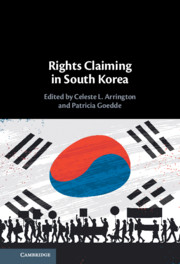Book contents
- Rights Claiming in South Korea
- Rights Claiming in South Korea
- Copyright page
- Dedication
- Contents
- Contributors
- Acknowledgments
- Abbreviations
- Introduction Rights in Action
- Part I Rights in Historical Perspective
- Part II Institutional Mechanisms for Rights Claiming
- 4 A Clash of Claims
- 5 Advancing Human Rights, Advancing a Nation
- 6 The Constitutional Court as a Facilitator of Fundamental Rights Claiming in South Korea, 1988–2018
- 7 Rights Claiming through the Courts
- 8 Public Interest Lawyering in South Korea
- Part III Mobilizing Rights for the Marginalized
- Part IV Shaping Rights for New Citizens and Noncitizens
- Conclusion Findings and Future Directions
- Index
- References
7 - Rights Claiming through the Courts
Changing Legal Opportunity Structures in South Korea
from Part II - Institutional Mechanisms for Rights Claiming
Published online by Cambridge University Press: 17 April 2021
- Rights Claiming in South Korea
- Rights Claiming in South Korea
- Copyright page
- Dedication
- Contents
- Contributors
- Acknowledgments
- Abbreviations
- Introduction Rights in Action
- Part I Rights in Historical Perspective
- Part II Institutional Mechanisms for Rights Claiming
- 4 A Clash of Claims
- 5 Advancing Human Rights, Advancing a Nation
- 6 The Constitutional Court as a Facilitator of Fundamental Rights Claiming in South Korea, 1988–2018
- 7 Rights Claiming through the Courts
- 8 Public Interest Lawyering in South Korea
- Part III Mobilizing Rights for the Marginalized
- Part IV Shaping Rights for New Citizens and Noncitizens
- Conclusion Findings and Future Directions
- Index
- References
Summary
Examining changes in the legal rules and procedures that render the courts more or less attractive for rights-claiming helps answer a core question: To what extent and how has civil litigation become an institutional mechanism for rights-claiming in South Korea? The concept of legal opportunity structures pinpoints the relatively stable but not static rules and statutes related to access to the courts, adjudication procedures, and judicial remedies that affect whether individuals and groups will use private litigation to try to enforce rights. This chapter’s analysis indicates that Koreans have benefited from a liberalizing structure of legal opportunities and improved potential for rights protection via the courts in the past two decades. I illustrate how claimants and lawyers are recognizing and using legal opportunities, and sometimes even prying open new opportunities, in pursuit of rights.
Keywords
- Type
- Chapter
- Information
- Rights Claiming in South Korea , pp. 151 - 171Publisher: Cambridge University PressPrint publication year: 2021



